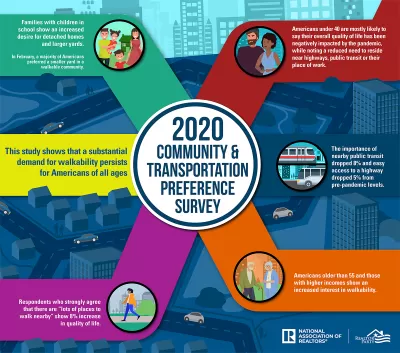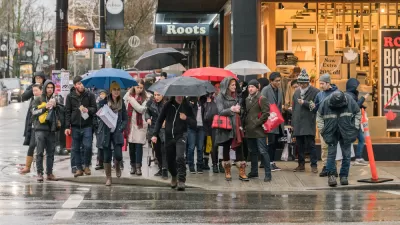The National Association of Realtors' recent Community and Transportation Preference Survey shows that many households prefer living in walkable urban neighborhoods, and those that do have a higher quality of life.

The National Association of Realtors' (NAR) 2020 Community and Transportation Preference Survey investigates how COVID has affected housing and travel preferences. It finds that many households would prefer to live in more walkable neighborhoods, and residents of such areas report a higher quality of life than those who live in less walkable areas.
NAR’s biannual Community & Transportation Preferences Surveys poll residents in America’s 50 largest metropolitan areas. The first 2020 survey was conducted in February, immediately before the impacts of COVID-19 began to be felt, and again at the end of July.
The survey found that Americans under 40 (millennials and Generation Y) are most likely to say their overall quality of life has been negatively impacted by the pandemic, while they also note a reduced need to reside near highways, public transit or their place of work. Although COVID has dramatically changed people’s lives, this study shows that a substantial demand for walkability persists for Americans of all ages,” Malta added.
Among other noteworthy findings of the July survey:
- Respondents who strongly agree that there are “lots of places to walk nearby” show an 8% increase in quality of life.
- Americans older than 55 and those with higher incomes show an increased interest in walkability.
- Families with children in school show an increased desire for detached homes and larger yards.
- The importance of easy access to public transit and highways dropped 8% and 5%, respectively, from pre-pandemic levels.
FULL STORY: Community and Transportation Preference Surveys

Planetizen Federal Action Tracker
A weekly monitor of how Trump’s orders and actions are impacting planners and planning in America.

Congressman Proposes Bill to Rename DC Metro “Trump Train”
The Make Autorail Great Again Act would withhold federal funding to the system until the Washington Metropolitan Area Transit Authority (WMATA), rebrands as the Washington Metropolitan Authority for Greater Access (WMAGA).

The Simple Legislative Tool Transforming Vacant Downtowns
In California, Michigan and Georgia, an easy win is bringing dollars — and delight — back to city centers.

The States Losing Rural Delivery Rooms at an Alarming Pace
In some states, as few as 9% of rural hospitals still deliver babies. As a result, rising pre-term births, no adequate pre-term care and "harrowing" close calls are a growing reality.

The Small South Asian Republic Going all in on EVs
Thanks to one simple policy change less than five years ago, 65% of new cars in this Himalayan country are now electric.

DC Backpedals on Bike Lane Protection, Swaps Barriers for Paint
Citing aesthetic concerns, the city is removing the concrete barriers and flexposts that once separated Arizona Avenue cyclists from motor vehicles.
Urban Design for Planners 1: Software Tools
This six-course series explores essential urban design concepts using open source software and equips planners with the tools they need to participate fully in the urban design process.
Planning for Universal Design
Learn the tools for implementing Universal Design in planning regulations.
Smith Gee Studio
City of Charlotte
City of Camden Redevelopment Agency
City of Astoria
Transportation Research & Education Center (TREC) at Portland State University
US High Speed Rail Association
City of Camden Redevelopment Agency
Municipality of Princeton (NJ)





























